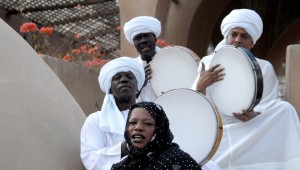When the High Dam was built in the 1960s, many Nubians immigrated to West Suhail in Aswan. An older Nubian man, Haj Nasser Al-Nouby, explains that many of them now host tourists for work, whether in the summer or winter.
Many families work in fishing, whether in Lake Nasser behind the High Dam or in front of it in the area between Aswan Dam and Aswan Reservoir, said Al-Nouby.
Al-Nouby explained that the price of one room in West Suhail houses during winter ranges between EGP 250 and EGP 350. He added that this price includes breakfast, as well as many other services, such as trips to Nile islands or temples in Aswan.
During summer, the prices fall as the temperature increases. In the summer when the temperature reaches more than 35 degrees Celsius, less people visit Aswan and the prices go as low as EGP 200 per person, according to Al-Nouby.
Al-Nouby believes these prices are very low. According to him, this could have never happened before 25 January, 2011. He explained that the prices used to be more than EGP 400, adding that those working in the tourism industry had to reduce all prices for Egyptians and foreigners.
Aswan has many five-star hotels, such as rge Cataract Hotel and Valentine, along with many archaeological shrines, among which are the Philae Temple located on an island between the High Dam and the Aswan Reservoir, as well as the temple of Abu Simbel near the Egyptian border with Sudan.
“During the past four years, the flow to Aswan diminished, even from the Western Europeans who loved the region with all of its details, especially the French and the British,” said Al-Nouby. He added that he hopes the situation will improve next winter.
Tourism income to Egypt during the past four years has been declining. It reached $7.3bn this year compared to $12.5bn by the end of 2010.
The total tourism income for Egypt in the first half of this year was $3.3bn versus $3.2bn during the same period last year.
The winter season is a key period in which the flow of tourists to Aswan increases, according to Ali Haroun, who works in the same industry as Al-Nouby, but in the Awaad island of Aswan near the Philae Temple.
“I drive a boat in daily trips between the Aswan Reservoir and the temple for EGP 10 per person,” said Haroun. He added that during the recent period numbers have decreased greatly. Foreigners used to take a voyage to Philae Temple then stay at Nubian houses in the area, he said, noting that families used to earn a lot of money for hosting tourists.
Aswan, as well as the city of Luxor, offers archaeological tourism and Nile cruises between the two cities. However, over the past four years those cruises have been suspended due to the weakness of foreign tourism, according to Tharwat Al-Agamy, Chairman of the Chamber of Tourism and Agencies in Upper Egypt. He added that Nile cruises, along with archaeological shrines, are considered among the most affected tourism types in the past four years.
Nearly 286 floating hotels work between Luxor and Aswan, 95% of which are currently not in operation, according to Abdul Rahman Anwar, Vice President of the Floating Hotels Investors Association.




